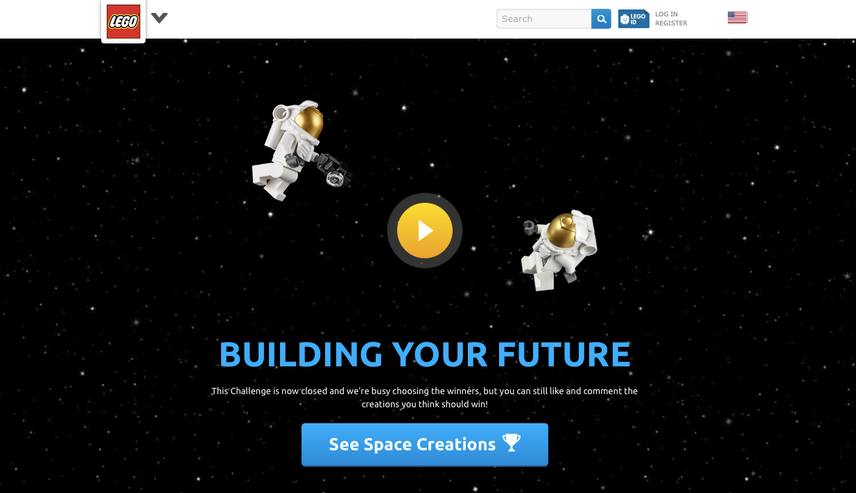How The LEGO Marketing Team Built Their Beloved Brand
How the LEGO marketing team identified and listened to the customer's voice to build their beloved brand.
The LEGO brand is known far and wide. In fact, on any list of the most beloved brands in the world, LEGO would place near the top. And deservedly so. Over the past 70 years, the LEGO brand has successfully built a toy dynasty and worked their way into the hearts of generations of children worldwide.
But companies can't manufacture customer affinity, it has to be earned. So how exactly has the LEGO marketing team developed the LEGO brand to be a cultural icon? How does LEGO employ a brand strategy that creates moments of joy for their customers?
Well that’s a story in two parts.
Identifying the Voice of the Customer
The LEGO marketing team began their journey by asking themselves a simple question: What engages our audience?
Questions like this are at the heart of customer-first marketing – and answering them is the first step in identifying the voice of the customer.
To find their answer, LEGO researched what topics, themes, and ideas interested their customers and came to a not-entirely surprising conclusion: kids really like outer space! But the way LEGO put this knowledge to use was anything but expected.
Out-of-This-World Marketing
In connection with NASA’s Juno mission to Jupiter, LEGO set up a partnership to help educate kids about space. They began creating educational and interactive content about science and space exploration that was engaging, informative, and fun.
At the same time, they took a step back from their products. They didn’t push any special deals on their customers or expect anything in return. They simply created valuable, relevant, and engaging content.

LEGO created a “Mission to Space” project with NASA, as well as a place for kids to upload images or ideas they had after interacting with their educational content. From that point on, kids became the content creators – spreading new ideas and creating new communities of customers all engaging with user-generated content.
LEGO built a brand strategy through user-generated content. They didn't have to ask if their strategy was aligning with their customers' expectations. Creating a system that allowed their customers to be part of their content ecosystem, LEGO ensured that their customers played an active role in their creation process early on, and that their expectations were met in the long run as well.
Let the Voice of the Customer Speak
Looking to replicate their customer-first success, LEGO partnered with Facebook to create a series of videos where kids were asked to build a “Kronkiwongi” from LEGO blocks. If you’re wondering what a “Kronkiwongi” looks like, you’re not alone – no one knew.
The kids had to use LEGO blocks and their imaginations to conjure up what a “Kronkiwongi” might look like.
Pushing the campaign one step further , LEGO reached out to their audience encouraging them to build their own Kronkiwongis and submit them to a webpage where others could see them. Again, the marketers at LEGO drove engagement by enabling their customers to create content in concert with each other.
LEGO only had to create seed content and a way for children to share their creations — what followed was customer-generated content that was perfectly relevant to their customers’ interests.
And while LEGO built customer affinity, children built fun memories.

So how can we implement similar strategies into our own marketing?
At first glance the strategy LEGO used, to partner with internationally-recognizable brands like Facebook and NASA, doesn’t seem replicable for every team. So what’s a three-person digital marketing team for a B2C widget manufacturer to do?
Get Creative with Customer Voice
The answer to this — as with many other marketing queries — is to get creative. After all, when you look closely at the strategy LEGO used, the pillars of their approach are four fundamental steps any customer-first marketer can implement:
- Research your customers’ interests.
- Create content that piques those interests.
- Provide avenues for customers to respond with their own content centered around those interests.
- Repeat.
If these examples from LEGO still seem unattainable, don’t be afraid to start small.
Customer-First Marketing: Go Big -- Or Small
This content comes straight from Conductor's C3 marketing conference, where Luis Navarette Gómez, Head of Global Search Marketing at LEGO, described how LEGO stays relevant by letting their customers — and the customer voice — drive their global strategy.
You can do customer-first marketing on a smaller scale, too. Here's an example: as attendees left registration at the NYC conference and walked into the central part of the venue, they were encouraged to write down their biggest marketing challenge on a sticky note and paste it on a wall.
A mosaic of pain points emerged, and as marketers walked by they could read the notes, sympathize, and converse. It was simple, and cost only the price of the sticky notes and a couple sharpies.

So get creative with your customer-first strategy. Remember the example of LEGO, and work tirelessly to provide valuable content for your customers that engages them in the conversation. What follows? Success.







